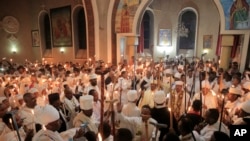At the Hamere Berhan Institute in Addis Ababa, priests and lay worshippers work by hand to replicate sometimes centuries-old religious manuscripts and sacred artwork.
The parchments, pens and inks are all prepared at the institute, which lies in the Piasa district in the historic heart of the Ethiopian capital.
Yeshiemebet Sisay, 29, who is in charge of communications at Hamere Berhan, says the work began four years ago.
"Ancient parchment manuscripts are disappearing from our culture, which motivated us to start this project," she says.
The precious works are kept mainly in monasteries, where prayers or religious chants are conducted using only parchment rather than paper manuscripts.
"However, this custom is rapidly fading... We thought if we could learn skills from our priests, we could work on it ourselves, so that is how we began," adds Yeshiemebet.
In the institute's courtyard, workers stretch the goatskins tightly over metal frames to dry under a weak sun which barely pierces the milky sky.
"After the goatskin is immersed in the water for three to four days, we make holes on the edge of the skin and tie it to the metal so that it can stretch," says Tinsaye Chere Ayele.
Once clean and dry, the skins are stripped of the goat hair and then cut to the desired size for use as pages of a book or for painting.
Yeshiemebet says most of the manuscripts are commissioned by individuals who then donate them to churches or monasteries.
Some customers order for themselves small collections of prayers or paintings to have "reproductions of ancient Ethiopian works," she adds.
"Small books can take one or two months. If it is a collective work, large books can take one to two years. "If it's an individual task, it can take even longer," she says.
Sitting in one of the institute's rooms, with parchment pages placed on his knees, Zelalem patiently copies a book entitled "Zena Selassie" ("History of the Trinity").
"It is going to take a lot of time. It's hard work, starting with the preparation of the parchment and the inks. This one could take up to six months to complete," the priest says.
"We make a stylus from bamboo, sharpening the tip with a razor blade."
The scribes use different pens for each color used in the text - black or red - and either a fine or broad tip, with the inks made from various local plants.
Like most other religious works, "Zena Selassie" is written in Ge'ez.
This dead language remains the liturgical language of the Ethiopian Orthodox Church and its alpha syllabic system - where the characters represent syllables - is still used to write Ethiopia's national language Amharic as well as Tigrinya, which is spoken in Tigray and neighboring Eritrea.
"We copy from paper to parchment to preserve (the writings) as the paper book can be easily damaged, while this one will last a long time if we protect it from water and fire," says Zelalem.
Replicating the manuscripts "needs patience and focus. It begins with a prayer in the morning, at lunchtime, and ends with prayer."
"It is difficult for an individual to write and finish a book, just to sit the whole day, but thanks to our devotion, a light shines brightly within us," Zelalem adds.
"It takes so much effort that it makes us worthy in the eyes of God."
Ethiopians Revive Ancient Parchments

ADDIS ABABA - Armed with a bamboo ink pen and a steady hand, Ethiopian Orthodox priest Zelalem Mola carefully copies text in the ancient Ge'ez language from a religious book onto a goatskin parchment. This painstaking task is preserving an ancient tradition says the 42-year-old.








Forum